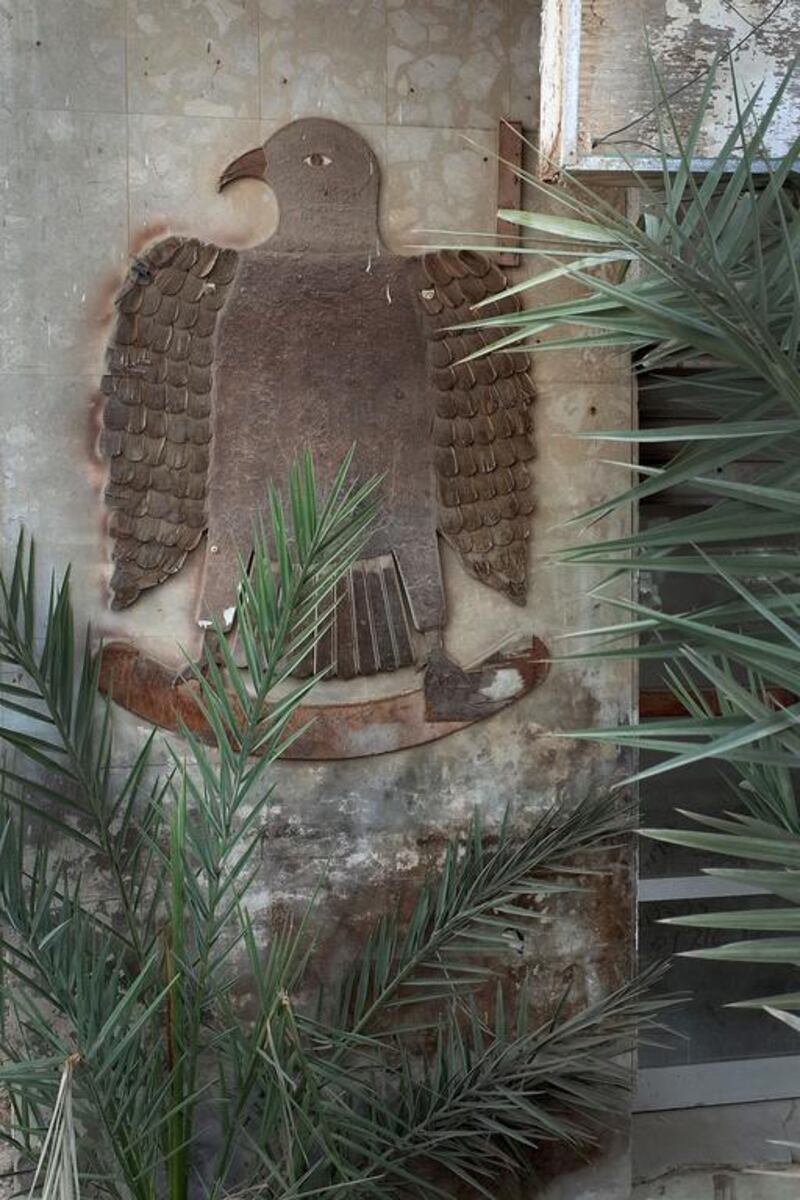Is it a bird? Is it a symbol? Or is it both? As the keen-eyed among you may have noticed, this humble sign is actually a home-made version of the UAE’s national emblem.
Unlike the falcon that serves as its inspiration, however, this bird is unlikely to arouse a sense of patriotism, but what it lacks as a national symbol, it more than makes up for with its charm.
If the bird’s maker weren’t a patriot, they certainly took great pride in their work and the care that went into this falcon’s making is palpable.
Each of the bird’s body parts – its eye, head, body and feathers – have been carefully and individually rendered in hardboard and plywood in ways that contrast the finish of both woods, and the result is an affectionate and a genuinely naive example of what could easily be defined as folk art.
The falcon perches behind a defunct neon sign on a soon-to-be-demolished building in Abu Dhabi’s Tanker Mai, a low-rise warren of bed-space-only apartment blocks, cafeterias, typing offices and furniture and fabric shops that feels abandoned by day, but comes to life after dark.
The neighbourhood may be the place to find warm tandoori bread, cheap fabric and hot, milky karak chai, but it is not a natural home for ad hoc expressions of Emirati nationalism, and the bird comes as a surprise to residents who seem oblivious to its presence.
Mohammed Yusuf Khan is one of the few who is willing to venture a guess about the bird’s origins. “Maybe it belonged to a typing office?” offers the 37-year-old bus driver, who is a regular customer at the nearby Rehana Cafeteria.
“Perhaps the sign would have shown people that it was a place where they could do business?”
In one sense Khan is correct. One of the few things that is certain about this inscrutable bird is that it is definitely a federal falcon and we know this because it grasps what remains of a piece of parchment that, on the official version at least, is inscribed in Arabic with “United Arab Emirates” in traditional Kufic script.
We will never know whether the sign also bore the official UAE escutcheon, a crest that is mounted on the bird’s chest, but if it had done then that might have provided a vital clue to its age.
In 1973, when the falcon was first adopted as the national emblem of the UAE, its crest featured a dhow surrounded by a chain, but in 2008 this design was updated and these were replaced by the national flag and a star for each of the seven emirates.
A symbol of the emirates of Abu Dhabi and Dubai as well as the Federal National Council, the falcon is an icon that communicates values of tradition, strength, serenity and status throughout the Arab world, not just because of the long history of falconry in the region, but also because of the bird’s longstanding associations with the Quraysh, the ancestral tribe of the Prophet Mohammed.
Thanks to those associations, the bird has also been chosen as a national emblem by the governments of Palestine, Syria, Libya and Kuwait at various points in their history and also graced the crest and flag of the Federation of Arab Republics, a short-lived attempt at a pan-Arabian state that included Syria, Egypt and Libya between 1972 and 1977.
When the government of Abu Dhabi’s falcon emblem was updated in 2013, the original crest, which was designed in 1968 by the Bahraini artist Abdullah Al Mahrouqi, was given a makeover and the national falcon became bigger, prouder, more upright and alert.
Despite all of these connotations, however, there is something delightfully off-message about the falcon of Tanker Mai. With its slender beak, almond eye and plentiful body, it is more dove than hawk and as peaceful as a predator can be.
As such it is reminiscent of the federal eagle, the “Bundesadler”, designed by the Expressionist sculptor Ludwig Gies for the new German parliament building, the Bundestag, which was built in Bonn in 1953.
Referred to by Germans of the post-war generation as the “fat hen”, Gies’s aluminium sculpture became synonymous with the economic miracle that transformed the ruins of Hitler’s Reich into a modern, successful parliamentary democracy, but when the current German parliament was moved back to its old home in post-unification Berlin, an updated federal eagle was required that would not be dwarfed by Foster and Partners’ renovated Reichstag.
The architect is reported to have favoured a leaner, keener and more aerodynamic rendering, but his proposal was criticised for being unacceptably aggressive. Instead, the members of the Bundestag opted for an enlarged version of Gies’s portly and intentionally unthreatening bird.
As the falcon of Tanker Mai and the Bundesadler show, the mysterious world of emblems is a place where eagles can become chickens and falcons can become doves. The symbols employed by nations reflect the tenor of their times.
Nick Leech is a features writer at The National.





